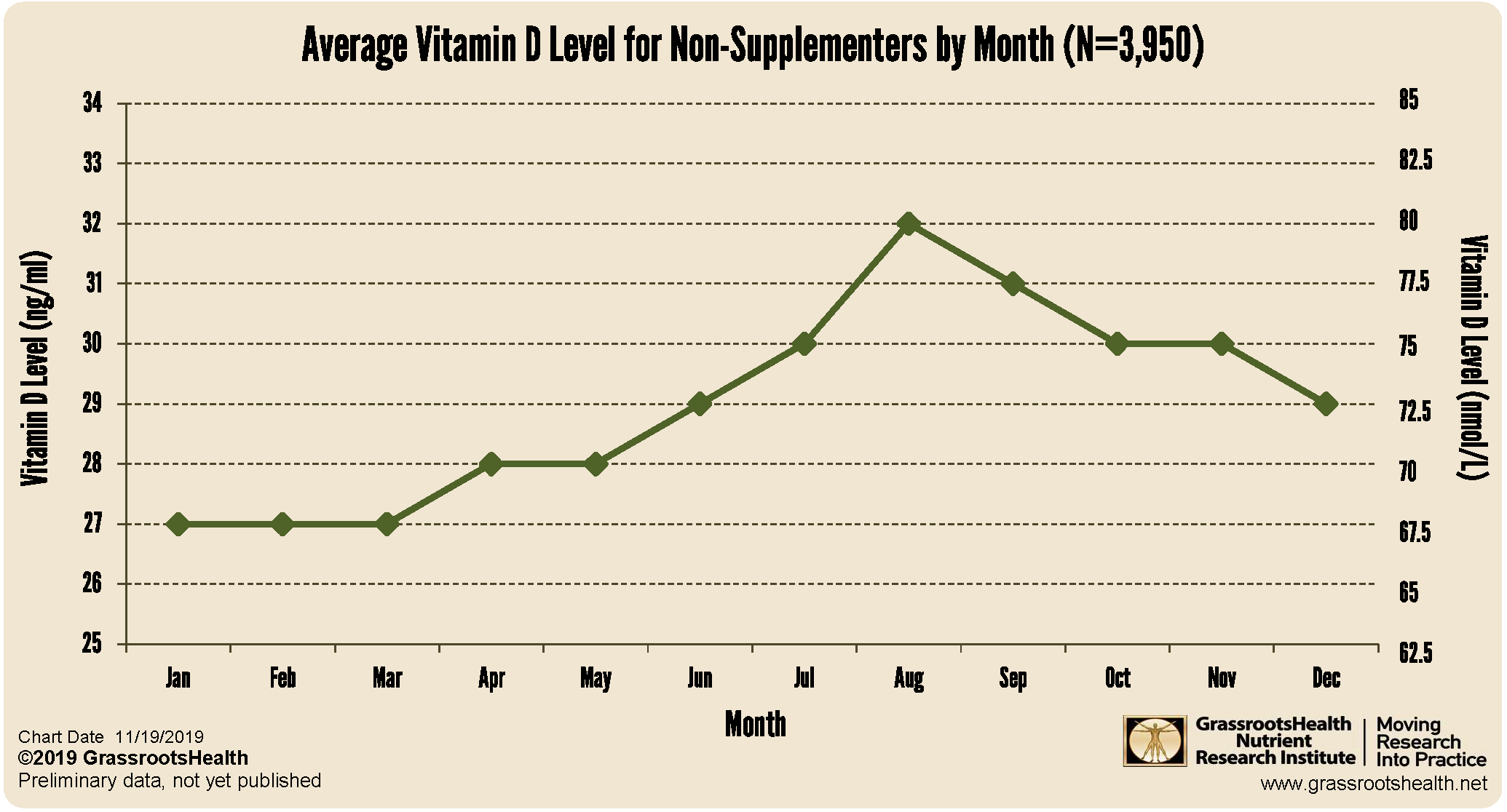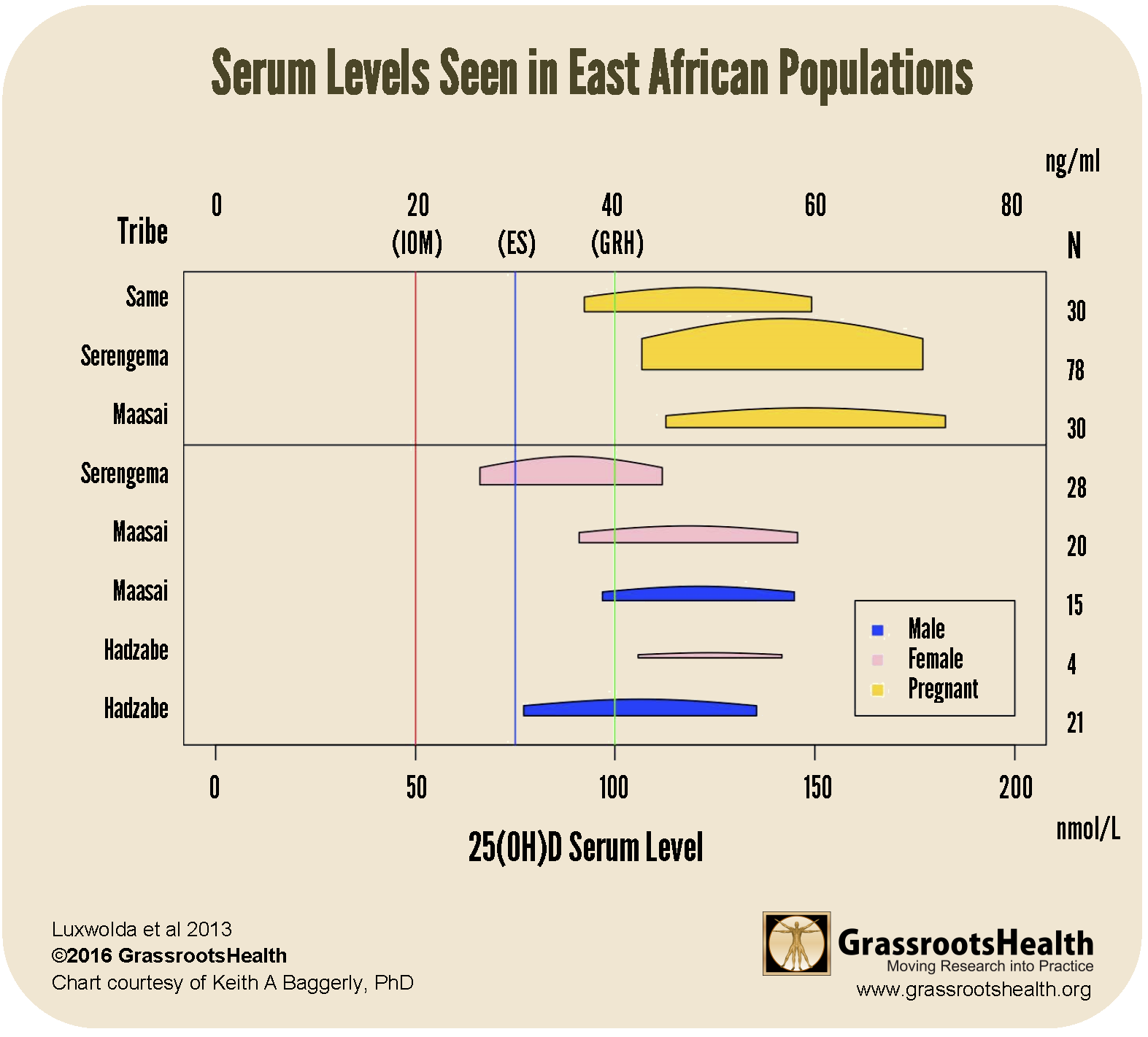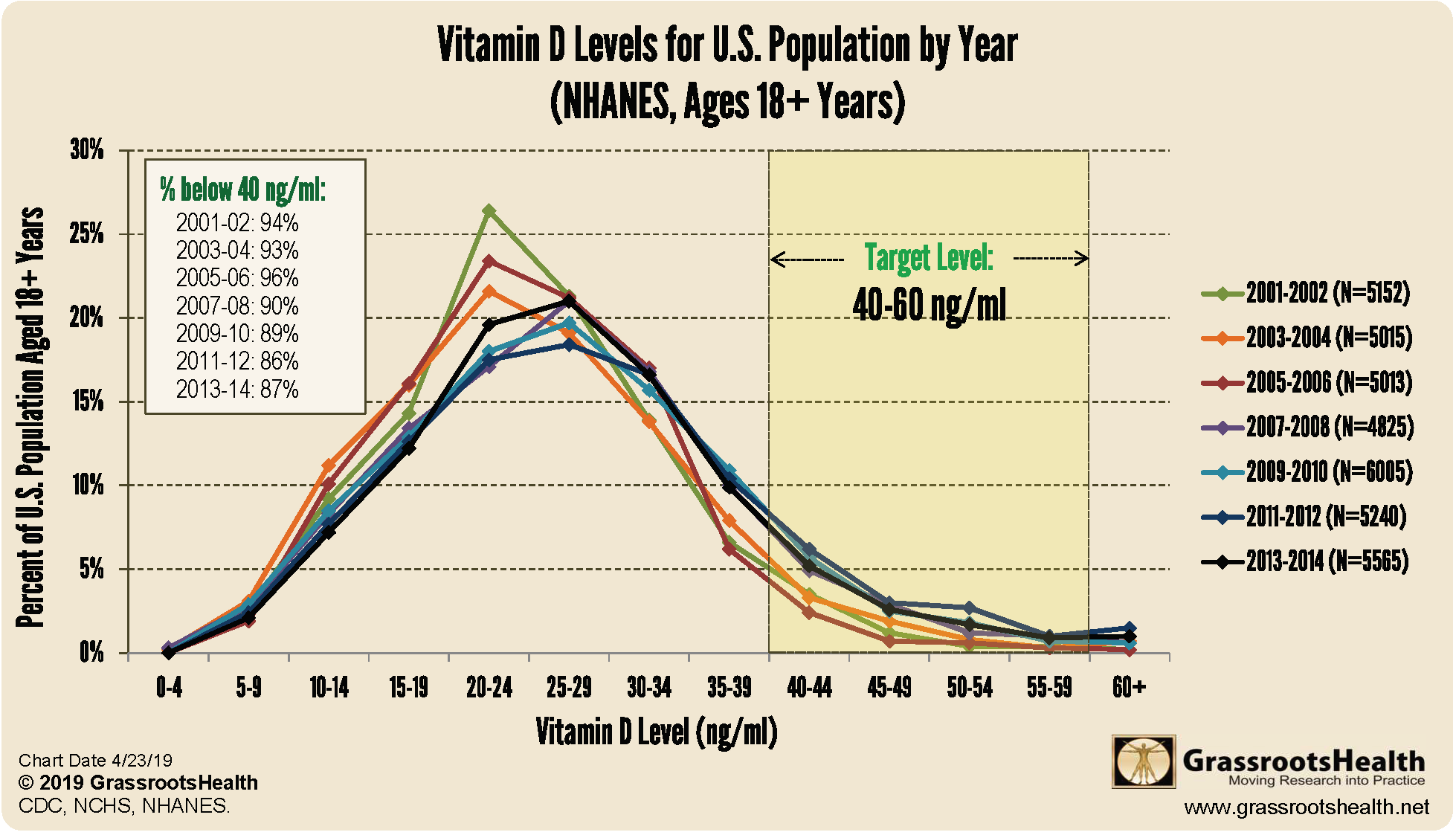Published on May 13, 2022
Depending on the circumstances, the body naturally produces enough vitamin D from sunshine to reach levels of 40-60 ng/ml (100-150 nmol/L) – how are you utilizing the sun for vitamin D production?
Key Points
- It takes more than exposing just the face, arms and legs for only 10-15 minutes per day for most people, and many may not be able get enough exposure simply due to other factors such as skin type, burning threshold, latitude, cloud cover, and time availability; results from a study published in 2018 showed that Caucasians living in the UK needed nine minutes of mid-day sun with arms and legs exposed each day from March to September to maintain a vitamin D level at or above 10 ng/ml (25 nmol/L) year-round
- Another study assessed vitamin D levels among 449 traditionally living Africans from five ethnic groups and found that the average vitamin D level was 43 ng/ml (107 nmol/L) in non-pregnant adults and 56 ng/ml (139 nmol/L) in pregnant women; these are natural levels achieved by sun exposure only, no supplementation
- Since there cannot be a single erythema dose or sun exposure time recommendation for everyone, due in part to skin type and other individual differences in vitamin D production, and because everyone responds differently to vitamin D, the only way to tell if you are getting enough for yourself is to test your level
 Centuries ago, Hippocrates (now considered the “Father of Medicine”) observed that the “sunnier side of the hill” was the healthier place to live. Because of this observation, he routinely prescribed sunbaths as part of his therapy for a wide variety of health ailments. While we now know that there are many benefits of proper sun exposure, the one with the greatest impact is most likely the production of vitamin D, and the reason it is dubbed the “sunshine vitamin.”
Centuries ago, Hippocrates (now considered the “Father of Medicine”) observed that the “sunnier side of the hill” was the healthier place to live. Because of this observation, he routinely prescribed sunbaths as part of his therapy for a wide variety of health ailments. While we now know that there are many benefits of proper sun exposure, the one with the greatest impact is most likely the production of vitamin D, and the reason it is dubbed the “sunshine vitamin.”
A common misconception and piece of advice shared today, even by some health care providers, is that “you probably get enough vitamin D with about 15 minutes to the face, arms, and hands at least twice a week without sunscreen.” Is this true?
In our last post we described how sunshine can be used to make vitamin D, when UVB rays are available for this to occur (which is not any time the sun is shining!), and several other influential factors. Today we present substantial evidence to show how unlikely it is, for most individuals with today’s modern lifestyle, to get enough vitamin D solely from their daily sun exposure habits, along with examples of several groups who are able to reach the recommended vitamin D levels of 40-60 ng/ml (100-150 nmol/L) with consistent sunshine exposure.
Vitamin D Levels among Individuals Who Don’t Supplement
Let’s first take a look at our own data to see what the vitamin D levels among those who don’t supplement are. Approximately 22% of GrassrootsHealth participants report that they do not take any vitamin D supplements. Using this data, we created a chart of the average vitamin D level for participants who do not use a vitamin D supplement by month to show the fluctuations in vitamin D levels over the year. As shown on the chart below, the lowest levels among GrassrootsHealth participants are between January and March. There is not a time during the year that these participants reach an average level of 40 ng/ml as recommended by our Scientists’ Panel.
All You Need is a Few Minutes of Sun Every Day?
Some studies do show that vitamin D levels in the range of 40-60 ng/ml (100-150 nmol/L) can be achieved with sun exposure alone, in groups such as lifeguards in southern California or hunter-gatherer tribes in Africa (more below). However, it takes more than exposing just the face, arms and legs for only 10-15 minutes per day for most people, and many may not be able get enough exposure simply due to other factors such as skin type, burning threshold, latitude, cloud cover, and time availability. For example, results from a study published in 2018 showed that Caucasians living in the UK needed nine minutes of mid-day sun with arms and legs exposed each day from March to September to maintain a vitamin D level at or above 10 ng/ml (25 nmol/L) year-round, which is significantly below the optimal range for health.
Recommended Levels found among those with Regular Sun Exposure and without Supplementation
One of the initial goals of GrassrootsHealth was to determine a recommended range for a target vitamin D level that could achieve the best health outcomes for the majority of the population. The consensus reached was 40-60 ng/ml (100-150 nmol/L), and each and every one of our now 48 scientists on that panel agree that this level is not only safe, but also a desirable target for the benefit of multiple health outcomes, including prevention of cancer, heart disease and respiratory infections such as COVID-19.
To determine the optimal vitamin D status from an evolutionary perspective based on evidence that humans originated in East Africa, Martine Luxwolda and Remko Kuipers, two Dutch researchers, assessed the vitamin D levels among 60 traditionally living Africans. They found that the average vitamin D level from members of two ethnic groups was 46 ng/ml (115 nmol/L) and that 72% had levels of 40 ng/ml or higher. In a second study, these researchers assessed vitamin D levels among 449 traditionally living Africans from five ethnic groups. Similar to their first study, they found that the average vitamin D level was 43 ng/ml (107 nmol/L) in non-pregnant adults and 56 ng/ml (139 nmol/L) in pregnant women as shown in the chart below.
Additionally, GrassrootsHealth tested the vitamin D levels among a group of San Diego beach lifeguards at summer’s end. The average vitamin D level was 45 ng/ml, and the majority of the lifeguards (69%) had vitamin D levels at or above 40 ng/ml. Since none of the lifeguards reported taking vitamin D supplements, observed vitamin D levels are primarily from sun exposure.
What is the Chance You Need More Vitamin D?
Vitamin D deficiency is abundant in today’s societies. Data from the National Health and Nutrition Examination Survey (NHANES), which collects health information from a representative sample of individuals living in the United States, shows the vitamin D levels for those aged 18 years and older by year (2001 to 2014). The average vitamin D level increased from 25 ng/ml in 2001-2002 to 28 ng/ml in 2013-2014 (62 to 69 nmol/L). The percent of adults below 20 ng/ml decreased from 26% to 23% during the same time period and those less than 40 ng/ml decreased from 94% to 87%. Even with these slight improvements, almost 90% of U.S. adults in the NHANES data set have a vitamin D level below the recommended range of 40-60 ng/ml!
Vitamin D Deficiency is Easily Corrected
While most of us cannot achieve a vitamin D level of 40-60 ng/ml (100-150 nmol/L) from sun alone, either due to our lifestyle, where we live, or other circumstances, we can certainly reach those levels with the right amount of supplementation. Studies have also shown that recommended vitamin D levels (>40 ng/ml or >100 nmol/L) can be reached using sunbeds containing UVB and following time exposure guidelines for your skin type, without adverse events. More on this topic next!
Let’s All Reach Our ‘Natural’ Levels of Vitamin D!
As can be seen above, vitamin D deficiency is abundant – the good news is, it is easily corrected.
According to Hippocrates, “The greatest medicine of all is teaching people how not to need it” – so, how can you use the sunshine vitamin to benefit your health? What amount is right for you?
As discussed in our previous post, a minimal erythema dose (defined by a pinkness of the skin about 1-6 hours after sun exposure, going away within 24 hours) is equivalent to roughly 10,000 – 25,000 IU of supplemental vitamin D, however, there is no single erythema dose or sun exposure time recommendation for everyone, due in part to skin type and other individual differences in vitamin D production. On top of this variability, everyone responds differently to vitamin D from supplements as well. The only way to tell if you are getting enough for yourself is to test your level – from there, use the vitamin D*calculator to help you determine a dose of vitamin D to achieve your desired target level, and choose either a regular daily maintenance dose (to reach your goal in approximately 3 months), or start with an initial “loading dose” to help bump it up more quickly (loading doses do not go above 25,000 IU per day, which is the amount our bodies can produce from proper sun exposure, and can help us reach our target level within only weeks).
Our vitamin D experts recommend testing twice per year – once during or just after the winter (when levels are most likely at their lowest), and once during or just after the summer (when levels are most likely at their highest). When is the last time you checked your vitamin D level?
Make Sure You are Getting Enough Vitamin D TODAY!
 Having and maintaining healthy vitamin D levels and other nutrient levels can help improve your health now and for your future. Choose which additional nutrients to measure, such as your omega-3s and essential minerals including magnesium and zinc, by creating your custom home test kit today. Take steps to improve the status of each of these measurements to benefit your overall health. With measurement you can then determine how much is needed and steps to achieve your goals. You can also track your own intakes, symptoms and results to see what works best for YOU.
Having and maintaining healthy vitamin D levels and other nutrient levels can help improve your health now and for your future. Choose which additional nutrients to measure, such as your omega-3s and essential minerals including magnesium and zinc, by creating your custom home test kit today. Take steps to improve the status of each of these measurements to benefit your overall health. With measurement you can then determine how much is needed and steps to achieve your goals. You can also track your own intakes, symptoms and results to see what works best for YOU.
Enroll in D*action and Test Your Levels Today!








